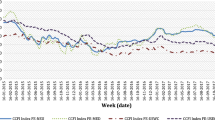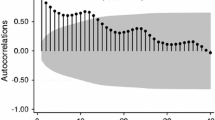Abstract
This study introduces a state-of-the-art volatility forecasting method for container shipping freight rates. Over the last decade, the container shipping industry has become very unpredictable. The demolition of the shipping conferences system in 2008 for all trades calling a port in the European Union (EU) and the global financial crisis in 2009 have affected the container shipping freight market adversely towards a depressive and non-stable market environment with heavily fluctuating freight rate movements. At the same time, the approaches of forecasting container freight rates using econometric and time series modelling have been rather limited. Therefore, in this paper, we discuss contemporary container freight rate dynamics in an attempt to forecast for the Far East to Northern Europe trade lane. Methodology-wise, we employ autoregressive integrated moving average (ARIMA) as well as the combination of ARIMA and autoregressive conditional heteroscedasticity (ARCH) model, which we call ARIMARCH. We observe that ARIMARCH model provides comparatively better results than the existing freight rate forecasting models while performing short-term forecasts on a weekly as well as monthly level. We also observe remarkable influence of recurrent general rate increases on the container freight rate volatility.



Similar content being viewed by others
References
Akaike, H. (1974) A new look at the statistical model identification. IEEE Transactions on Automatic Control 19(6): 716–723.
Alixpartners (2015) Container Shipping Outlook [Online]. http://www.alixpartners.com/en/Publications/AllArticles/tabid/635/articleType/ArticleView/articleId/1590/Finding-Focus.aspx#sthash.Gxl2chd8.dpbs, accessed 15 December 2015.
Alphaliner (2013a) Alphaliner Weekly Newsletter, 2013(21), 14/05–20/05/2013.
Alphaliner (2013b) Alphaliner Weekly Newsletter, 2013(42), 08/10–14/10/2013.
Alphaliner (2013c) Alphaliner Weekly Newsletter, 2013(48), 19/11–25/11/2013.
Alphaliner (2014) Alphaliner Weekly Newsletter, 2014(51), 16/12–22/12/2014.
Alphaliner (2015) Alphaliner Weekly Newsletter, 2015(24), 10/06–16/06/2015.
Balticexchange (n.d.) Ningbo Containerised Freight Index. http://www.balticexchange.com/market-information/containers/
Batchelor, R., Alizadeh, A. and Visvikis, I. (2007) Forecasting spot and forward prices in the international freight market. International Journal of Forecasting 23(1): 101–114.
Beenstock, M. and Vergottis, A. (1993) Econometric Modelling of World Shipping. London: Chapman & Hall.
Benth, F.E. and Koekebakker, S. (2015) Stochastic modeling of Supramax spot and forward freight rates. Maritime Economics and Logistics, doi:10.1057/mel.2015.22.
Box, G.E. and Jenkins, G.M. (1976) Time series analysis: forecasting and control, revised ed., San Francisco: Holden-Day.
Cariou, P. and Cheaitou, A. (2014) Cascading effects, network configurations and optimal transhipment volumes in liner shipping. Maritime Economics and Logistics 16(3): 321–342.
Caschili, S., Medda, F., Parola, F. and Ferrari, C. (2014) An analysis of shipping agreements: the cooperative container network. Networks and Spatial Economics 14(3–4): 357–377.
Chen, S., Meersman, H. and van de Voorde, E. (2010) Dynamic interrelationships in returns and volatilities between Capesize and Panamax markets. Maritime Economics and Logistics 12(1): 65–90.
Chen, S., Meersman, H. and van de Voorde, E. (2012) Forecasting spot rates at main routes in the dry bulk market. Maritime Economics and Logistics 14(4): 498–537.
CI (2009) Freight Rate Data. Containerisation International. London: Informa.
CTS (n.d.) Container Trade Statistics. Woking: Container Trades Statistics Ltd.
Cullinane, K. (1992) A short-term adaptive forecasting model for BIFFEX speculation: A Box–Jenkins approach. Maritime Policy and Management 19(2): 91–114.
Cullinane, K., Mason, K. and Cape, M. (1999) A comparison of models for forecasting the Baltic freight index: Box–Jenkins revisited. Maritime Economics and Logistics 1(2): 15–39.
Dickey, D.A. and Fuller, W.A. (1981) Likelihood ratio statistics for autoregressive time series with a unit root. Econometrica 49(4): 1057–1072.
Dixon, M. (2010) Hedging your bets. Containerisation International 43(8): 26–29.
Drewry Maritime Research (2011) Unmasking Freight Rates. London: Drewry Maritime Research.
Drewry Shipping Consultants (2012) Index-Linked Container Contracts. London: Drewry Shipping Consultants Ltd.
Dupin, C. (2010) Hedging your box bets, American Shipper 52(3): 34–37.
EC (2008) Guidelines on the application of Article 81 of the EC Treaty to maritime transport services 2008/C 245/02. Brussels: European Commission.
EC (2016) Press Release IP/16/317. Brussels: European Commission.
Engle, R.F. (1982) Autoregressive conditional heteroskedasticity with estimates of the variance of UK. inflation. Econometrica 50(4): 987–1008.
Engle, R.F. and Granger, C.W. (1987) Co-integration and error correction: representation, estimation, and testing. Econometrica 55(2): 251–276.
Evangelista, P. and Morvillo, A. (1999) Alliances in Liner shipping: an instrument to gain operational efficiency or supply chain integration? International Journal of Logistics: Research and Applications 2(1): 21–38.
Fama, E.F. (1970) Efficient capital markets: A review of theory and empirical work. Journal of Finance 25(2): 383–417.
Fan, L. (2011) Econometric analyses of container shipping market and capacity development. PhD Thesis, The Hong Kong Polytechnic University, Hong Kong.
Ferrari, C., Parola, F. and Tei, A. (2015) Determinants of slow steaming and implications on service patterns. Maritime Policy and Management 42(7): 636–652.
Fung, M.K. (2014) Ocean carriers’ collusion under antitrust immunity: Evidence of asymmetric pass-through. Review of Industrial Organization 45(1): 59–77.
Fusillo, M. (2004) Is liner shipping supply fixed? Maritime Economics and Logistics 6(3): 220–235.
Goulielmos, A.M., Giziakis, C. and Georgantzi, A. (2012) An application of non-linear methods to the prediction of future freight rates, 2006–2008. International Journal of Shipping and Transport Logistics 4(1): 78–106.
Gujarati, D.N. (2003) Basic Econometrics (4th ed.). New York: McGraw-Hill.
Hoffmann, J. (2010) Shipping Out of the Economic Crisis. Brown Journal of World Affairs 16(2): 121–130.
Jarque, C.M. and Bera, A.K. (1980) Efficient tests for normality, homoscedasticity and serial independence of regression residuals. Economics letters 6(3): 255–259.
Karamperidis, S., Jackson, E. and Mangan, J. (2013) The use of indices in the maritime transport sector. Maritime Policy and Management 40(4): 339–350.
Kavussanos, M.G. (1996) Price risk modelling of different size vessels in the tanker industry using autoregressive conditional heteroskedastic (ARCH) models. Transportation Research Part E: Logistics and Transportation Review 32(2): 161–176.
Kavussanos, M.G., Visvikis, I.D. and Batchelor, R.A. (2004) Over-the-counter forward contracts and spot price volatility in shipping. Transportation Research Part E: Logistics and Transportation Review 40(4): 273–296.
Kavussanos, M., Visvikis, I. and Dimitrakopoulos, D. (2010) Information linkages between Panamax freight derivatives and commodity derivatives markets. Maritime Economics and Logistics 12(1): 91–110.
Kavussanos, M.G., Visvikis, I.D., and Dimitrakopoulos, D.N. (2015) Freight Markets and Products. In: A. Roncoroni, G. Fusai and M. Cumrins (eds.) Handbook of Multi-Commodity Markets and Products: Structuring, Trading and Risk Management. Wiley, pp. 355–398.
Li, K.X., Qi, G., Shi, W., Yang, Z., Bang, H.-S., Woo, S.-H. and Yip, T.L. (2014) Spillover effects and dynamic correlations between spot and forward tanker freight markets. Maritime Policy and Management 41(7): 683–696.
Ljung, G.M. and Box, G.E. (1978) On a measure of lack of fit in time series models. Biometrika 65(2): 297–303.
Luo, M., Fan, L. and Liu, L. (2009) An econometric analysis for container shipping market. Maritime Policy and Management 36(6): 507–523.
Marlow, P. and Nair, R. (2008) Service contracts - An instrument of international logistics supply chain: Under United States and European Union regulatory frameworks. Marine Policy 32(3): 489–496.
Mason, R. and Nair, R. (2013) Supply-side strategic flexibility capabilities in container liner shipping. The International Journal of Logistics Management 24(1): 22–48.
Midoro, R. and Pitto, A. (2000) A critical evaluation of strategic alliances in liner shipping. Maritime Policy & Management 27(1): 31–40.
Miller, K., Ward, R., Craig, A.W., Lowe, E.K., Kroll, C.A., Hale, T., Miller, E., Cassels, J., Schöne, S. and Höth, A. (2015) Risk Management and Applications. In: O. Schinas, C. Grau and M. Johns (eds.) HSBA Handbook on Ship Finance. Berlin: Springer, pp. 297–321.
Murphy, A. (2016) The three final alliances, Lloyds List – Containers. https://www.lloydslist.com/ll/sector/containers/article528140.ece, accessed 17 June 2016.
Nielsen, P., Jiang, L., Rytter, N.G.M. and Chen, G. (2014) An investigation of forecast horizon and observation fit’s influence on an econometric rate forecast model in the liner shipping industry. Maritime Policy and Management 41(7): 667–682.
Notteboom, T. and Cariou, P. (2013) Slow steaming in container liner shipping: is there any impact on fuel surcharge practices? The International Journal of Logistics Management 24(1): 73–86.
Panayides, P.M. and Wiedmer, R. (2011) Strategic alliances in container liner shipping. Research in Transportation Economics 32(1): 25–38.
Sims, C.A. (1980) Macroeconomics and reality. Econometrica 48(1): 1–48.
Slack, B. (2010) Battening down the hatches: How should the maritime industries weather the financial tsunami? Research in Transportation Economics 27(1): 4–9.
Slack, B. and Gouvernal, E. (2011) Container freight rates and the role of surcharges. Journal of Transport Geography 19(6): 1482–1489.
SSE (n.d.) Shanghai Shipping Exchange. http://en.sse.net.cn/index.jsp.
SSE (2016a) About CCFI. http://en.sse.net.cn/indices/introduction_ccfi_new.jsp, accessed 15 January 2016.
SSE (2016b) About SCFI. http://en.sse.net.cn/indices/introduction_scfi_new.jsp, accessed 15 January 2016
Stopford, M. (2009) Maritime Economics (3rd ed.). New York: Routledge.
Strandenes, S.P. and Wergeland, T. (1982) Freight Markets and Bulk Demand Efficiency. Norwegian School of Economics and Business Administration.
Tinbergen, N. (1959) Behaviour, systematics, and natural selection. Ibis 101(3–4): 318–330.
UNCTAD (2015) Review of Maritime Transport. Geneva: United Nations Conference on Trade and Development.
Verbeek, M. (2008) A Guide to Modern Econometrics. Hoboken: Wiley.
Wang, D.H., Chen, C.C. and Lai, C.S. (2011) The rationale behind and effects of Bunker Adjustment Factors. Journal of Transport Geography 19(4): 467–474.
WCI (n.d.) The World Container Index. http://www.worldcontainerindex.com.
Zannetos, Z.S. (1966) The Theory of Oil Tankship Rates. Cambridge: MIT Press.
Acknowledgements
The paper is the recipient of the Palgrave Macmillan prize for best conference paper at the International Association of Maritime Economists (IAME) conference, Hamburg, August 2016. The authors are indebted to Sebastian Kummer for constructive comments and suggestions on an earlier version of the manuscript. Authors are also thankful to Jann Goedecke for useful suggestions.
Author information
Authors and Affiliations
Corresponding author
Rights and permissions
About this article
Cite this article
Munim, Z.H., Schramm, HJ. Forecasting container shipping freight rates for the Far East – Northern Europe trade lane. Marit Econ Logist 19, 106–125 (2017). https://doi.org/10.1057/s41278-016-0051-7
Published:
Issue Date:
DOI: https://doi.org/10.1057/s41278-016-0051-7




